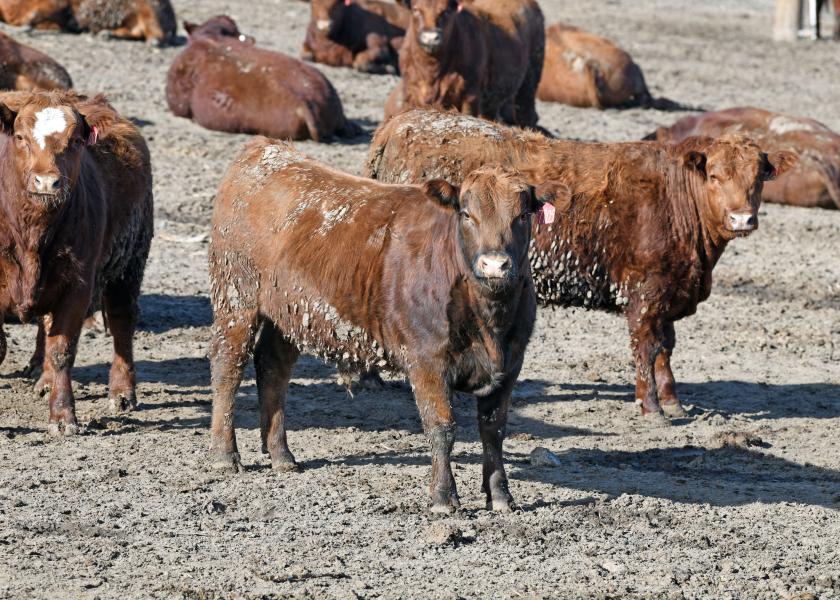4 Tips for Avoiding BRD This Season

Winter cold and storms are here, and the risk for bovine respiratory disease (BRD) in cattle may be right around the corner as well. A little planning can go a long way in handling the pressures of Mother Nature and managing cattle to stay ahead of a BRD outbreak.
Phillip Kesterson, DVM, Beef Technical Services, Zoetis, suggests considering these four factors this season:
• Temperature fluctuations. While humans may enjoy “layering weather,” it can be hard on cattle in grow yards. When the morning starts out cold, then warms up 30 degrees or more during the day and cools off again at night, we can remove or add layers, but cattle can’t. The fluctuations can cause respiratory stress, so watch cattle for signs of illness.
• Dusty days. Dry weather can cause respiratory issues for cattle in dry lots. While producers do everything they can to address and mitigate this issue, they can’t do much if Mother Nature doesn’t provide some moisture. Keep an eye on cattle during the dusty days for signs of distress.
• Commingling Issues. You might be thinking the risk is past, but don’t be overconfident that cattle are beyond the period of vulnerability caused by commingling. Mixing cattle exposes them to new pathogens when immune systems may be suppressed, so keeping a constant eye on emerging signs of disease is important.
• Long-duration treatments. With labor often in short supply, using a long-duration anti-infective treatment for BRD allows for returning cattle to their home pens where they feel more comfortable, thus decreasing the likelihood of subsequent treatments.
Speaking of treatments, what’s your clients' strategies?
If you and they do encounter a BRD issue, having a set protocol and plan for treatment is essential to help get cattle feeling better and back on feed.
Dr. Kesterson encourages you to consider the new BRD treatment available that combines the long-duration of the leading antibiotic on the market1 with a fast-acting NSAID, ketoprofen, for fever control: Draxxin KP (tulathromycin and ketoprofen injection) Injectable Solution.
This new BRD treatment:
• Provides 14 days of antibiotic therapy:
o Draxxin KP contains the trusted antibiotic tulathromycin and maintains antibacterial therapeutic levels for up to 14 days.2
• Controls fever starting in one hour up to 24 hours to help animals feel better:
o Draxxin KP demonstrated a significant reduction (p ≤ 0.0072) of BRD-associated fever from one hour up to 24 hours after treatment compared with Draxxin (tulathromycin injection) Injectable Solution alone.3
• Has similar year-round syringeability as Draxxin:
o Draxxin KP is approved for the same dose size as Draxxin and has similar viscosity.
• Treats all four major BRD pathogens:
o Draxxin KP is labelled to treat BRD caused by Mannheimia haemolytica, Pasteurella multocida, Histophilus somni and Mycoplasma bovis.4
• Improved respiratory scores for better animal well-being:
o A challenge study demonstrated animals treated with Draxxin KP showed numerically improved attitude and respiratory scores compared with animals treated with saline and Draxxin post-treatment.3
Talk with your veterinarian to evaluate your BRD management and treatment protocols, and learn more about Draxxin KP at www.draxxinkp.com.
IMPORTANT SAFETY INFORMATION FOR DRAXXIN KP: Draxxin KP has a pre-slaughter withdrawal time of 18 days in cattle. Not for use in female dairy cattle 1 year of age or older, including dry dairy cows. Not for use in beef calves less than 2 months of age, dairy calves, and veal calves. A withdrawal period has not been established for this product in pre-ruminating calves. Do not use in animals previously found to be hypersensitive to tulathromycin and ketoprofen. See full Prescribing Information.
IMPORTANT SAFETY INFORMATION FOR DRAXXIN: Draxxin has a pre-slaughter withdrawal time of 18 days in cattle. Do not use in female dairy cattle 20 months of age or older. Do not use in animals known to be hypersensitive to the product. See full Prescribing Information.







